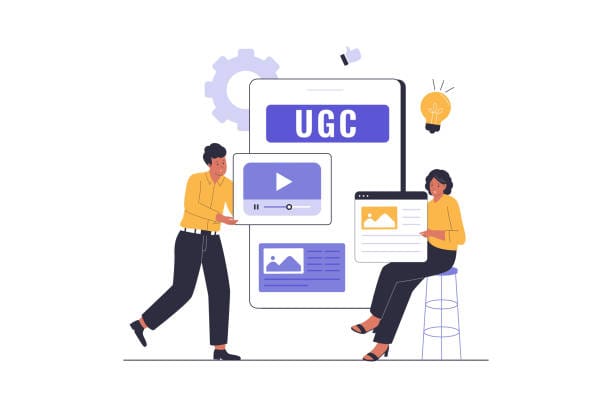You’ve probably come across UGC content without even noticing.
A selfie of someone holding their favorite drink?
A short review someone left on a product page?
An Instagram story tagging a brand?
Yep. That’s all UGC.
It’s short for User-Generated Content, and it’s everywhere now.
And if you’re in digital marketing—or even just trying to sell something online—understanding how UGC works (and why it matters) is honestly non-negotiable.
Let’s break it down.
What is UGC Content?

UGC content means any kind of content—photos, videos, reviews, testimonials, or posts—created by people, not brands.
The key thing?
It’s made by users. Not marketers. Not influencers paid for a campaign. Real people.
And they’re usually not doing it for money. They’re just sharing because they genuinely like something. Or maybe they just want to show it off.
Examples of UGC content:
- A customer’s tweet about a new phone
- A YouTube unboxing of sneakers
- A 5-star review on an eCommerce store
- A TikTok showing how to style a thrifted outfit
- A Reddit comment comparing two laptops
It’s raw. It’s relatable. It’s usually unfiltered.
And that’s why people trust it.
Why is UGC So Powerful in Digital Marketing?
Let’s be real—most of us don’t fully believe ads anymore.
We skip them, scroll past them, block them.
But when we see a person (who’s not sponsored) rave about something?
That hits different.
Here’s why UGC matters more than ever.
1. People Trust People
It’s simple. You trust your friends more than a billboard.
- 84% of people say they trust peer recommendations more than any other form of advertising (Nielsen).
- When someone shares real experiences, it feels honest.
You can’t buy that kind of trust. But you can earn it.
2. UGC Increases Conversions
Say you’re shopping online.
You find two similar products. One has a bunch of customer photos and video reviews. The other? Just polished brand images.
Which one are you more likely to buy?
Exactly.
- Pages with UGC see 29% higher web conversions (source: Yotpo).
- Product reviews alone can increase purchase likelihood by 270% (source: Spiegel Research Center).
That’s not fluff. That’s impact.
3. UGC Saves Time and Budget
Creating content takes time. And effort. And money.
With UGC, your customers do it for you.
You don’t have to plan a full shoot or write 50 new captions. Just reshare what your audience is already posting (with permission, of course).
It’s like crowdsourcing your content. And it works.
4. It Builds Community
People love to feel seen. When a brand shares its post, it feels personal.
- It encourages more engagement.
- It sparks loyalty.
- It makes your audience feel like they’re part of something.
It’s not just about the product anymore. It’s about people connecting around it.
5. UGC Helps With SEO (Yep, Really)
Search engines love fresh, relevant content. And UGC provides that.
- New reviews mean updated product pages.
- Blog comments keep your site active.
- User photos with tagged metadata can even show up in image search.
It tells Google your content is alive, not just a static ad page.
And with the EEAT algorithm (Experience, Expertise, Authoritativeness, Trust), this kind of real-world interaction can support your credibility in subtle but meaningful ways.
How UGC Supports the EEAT Algorithm
Google’s EEAT framework is part of how it ranks content.
Here’s how UGC content naturally helps meet EEAT signals:
- Experience – Real users share real product use cases. That’s first-hand knowledge, not hypothetical.
- Expertise – Longtime users often provide tips, hacks, and detailed reviews that show deep familiarity.
- Authoritativeness – A brand constantly mentioned by real people gains weight in their niche.
- Trust – UGC builds social proof. People trust what others have already tested.
You don’t need to overthink it. Let your customers do the talking. Their words go a long way with Google.
Where to Use UGC Content

UGC isn’t just for Instagram.
You can—and should—spread it across your entire marketing funnel.
Here’s where it works best:
- Product Pages: Embed reviews, photos, and video testimonials
- Social Media: Reshare customer content with credit
- Email Marketing: Feature customer shoutouts or feedback
- Paid Ads: Use real user clips (after asking permission)
- Landing Pages: Add social proof from past buyers
- Blogs: Include quotes from users, or link to YouTube reviews
It’s about showing—not just telling—what your product does in the real world.
How to Encourage More UGC
Okay, so UGC is valuable. But what if no one’s posting about your brand yet?
No worries. You can nudge people a bit.
Here’s how:
- Ask directly: After purchase, send a follow-up asking for a review or photo.
- Create a hashtag: Something simple and brand-related that users can tag.
- Run a contest: “Post a pic with our product and win a gift card.”
- Feature users: Show that you do share UGC. It motivates others to post.
- Make it easy: Let users upload reviews, tag you, or share directly from your site.
People are more likely to create content when they know it’ll be seen.
Mistakes to Avoid With UGC Content
Not everything your users post will be perfect for your brand.
Watch out for these:
- Using content without permission: Always ask first.
- Not crediting the creator: Tag them or mention their name.
- Over-editing UGC: Keep it authentic. That’s the point.
- Ignoring negative feedback: Even critical reviews are content. Handle them honestly.
UGC is about realness. Don’t sanitize it too much.
Real-World Examples of UGC Content in Action
Let’s look at how real brands are doing this.
- GoPro: Most of their Instagram feed is filled with user-submitted action shots.
- Glossier: They built an entire community off user selfies and product reviews.
- Airbnb: They showcase actual guests and hosts—stories, homes, and experiences.
- Lush Cosmetics: Reposts customer bath bomb videos and raw product demos.
These aren’t just posts. They’re trust-builders.
UGC content isn’t a trend. It’s how people talk about brands now.
It feels honest because it is honest.
It builds trust. It drives sales.
It gives your brand a voice that’s bigger than yours alone.
And you don’t need a huge following or big budget to start using it.
Just start with what you’ve got. Ask your happy customers. Share their stories.
That’s where the magic is.




